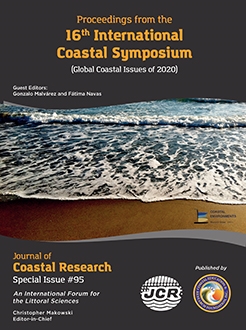Pereira, L.C.C.; Trindade, W.; Nascimento, A.T.; Vila Concejo, A., and Jimenez, J.A., 2020. Morphodynamic studies in sandy Amazonian environments. In: Malvárez, G. and Navas, F. (eds.), Global Coastal Issues of 2020. Journal of Coastal Research, Special Issue No. 95, pp. 403–407. Coconut Creek (Florida), ISSN 0749-0208.
The present study evaluated the different morphodynamic scenarios that arise under varying tidal and wave conditions on a sandy beach (Ajuruteua) and an exposed tidal flat (Vila dos Pescadores) on the Amazon coast of northern Brazil. For this, four field campaigns were conducted, covering a full annual cycle, for the collection of nearshore data (tides, waves, rainfall, topographic changes, and sediment characteristics). These data were complemented with meteorological (rainfall), fluvial discharge and offshore (wave and wind) data obtained from the stations of official agencies. Ajuruteua beach has very fine sand (2.1-2.7 φ) with a typical profile characterized by a narrow high-tide zone (<10 m) and intertidal zone with a low-gradient (1°–2°) and varying width, ranging from 250 m (neap tide) to 350 m (spring tide). At that beach, tidal flat conditions occur primarily during the equinoctial period, when tidal asymmetry is strongest (ebb tide longer than 7 h). At Vila dos Pescadores, the sand is also fine (more than 70% of grain 2.0-3.0 φ) and the migration of the main tidal channel is delimited by a low, broad terrace. In this area, the transition between tide-dominated, tide-modified, and wave-dominated conditions occurs during the high tide, primarily during the dry season, when the highest Hs values (up to 1.3 m) are recorded on the tidal flat. In the study region, the unregulated construction of buildings has resulted in increasing impacts from erosive processes, which has partially or totally destroyed the existing beachfront infrastructure. The results of the present study provide important insights for the development of more effective management strategies for the local environments.





